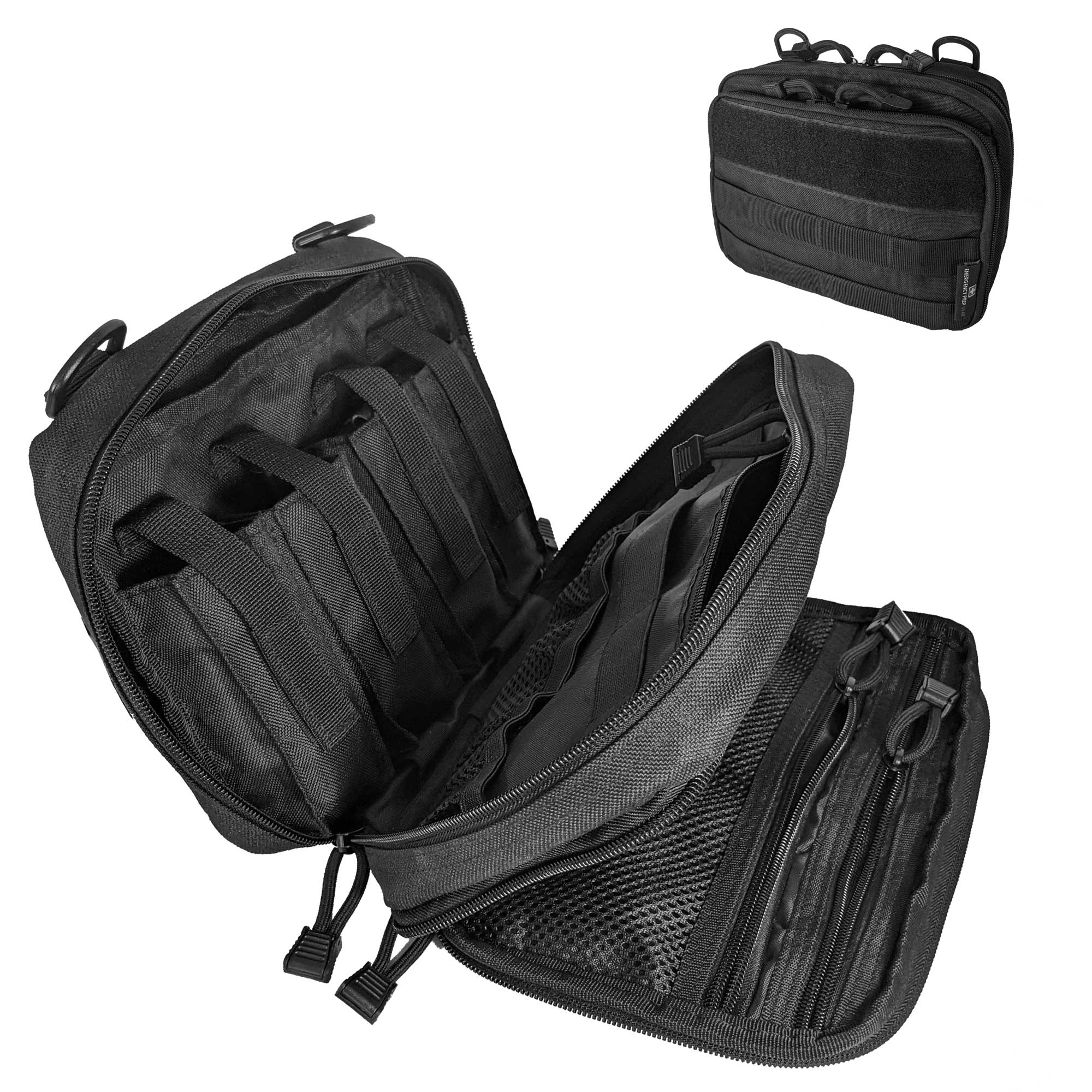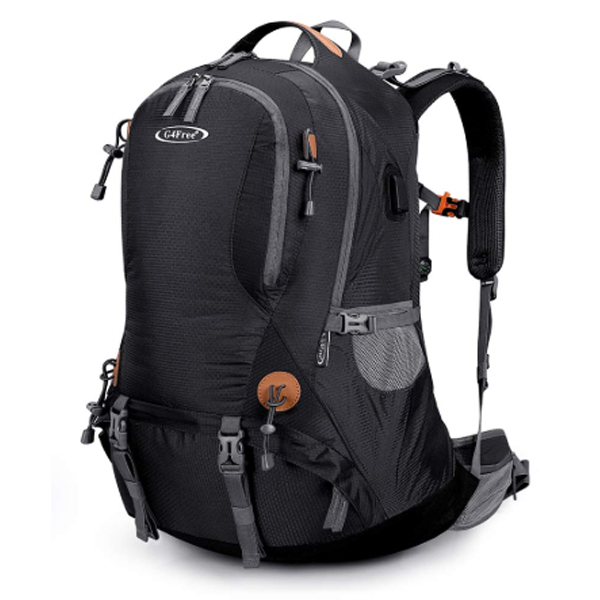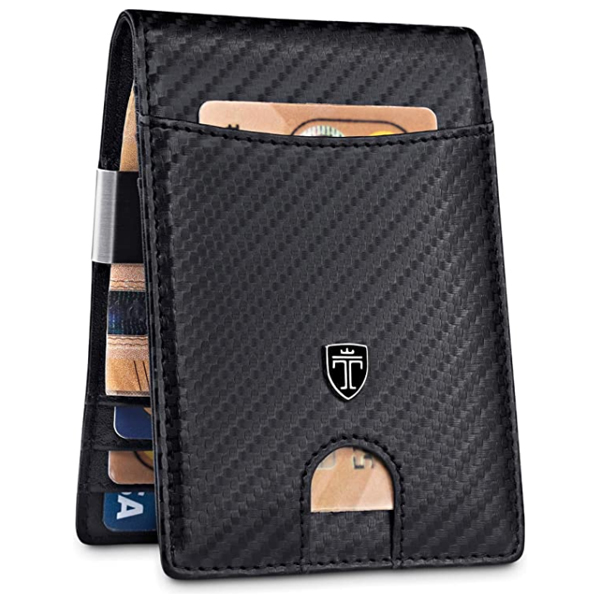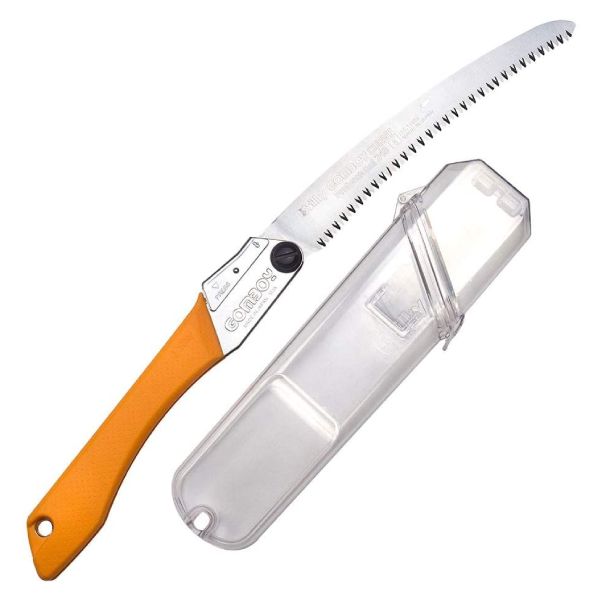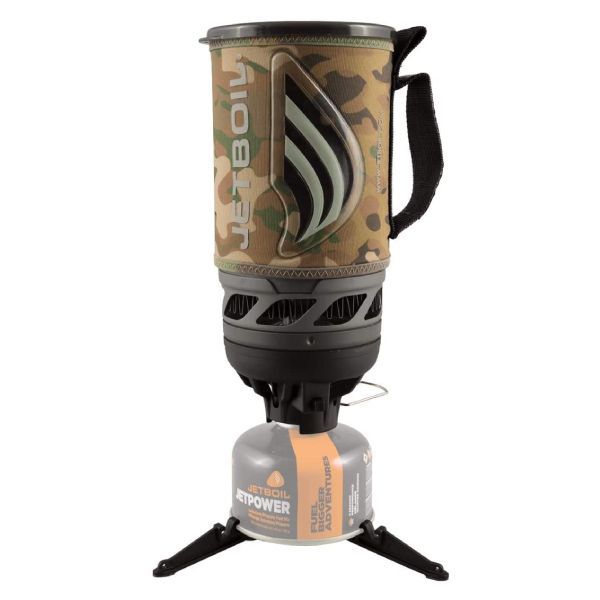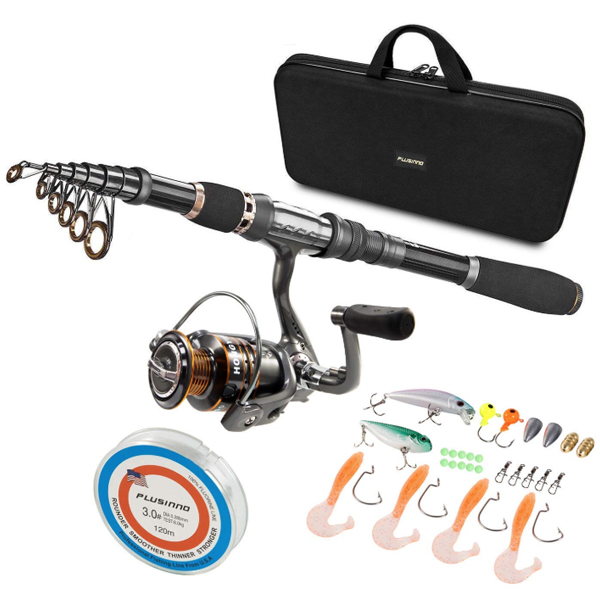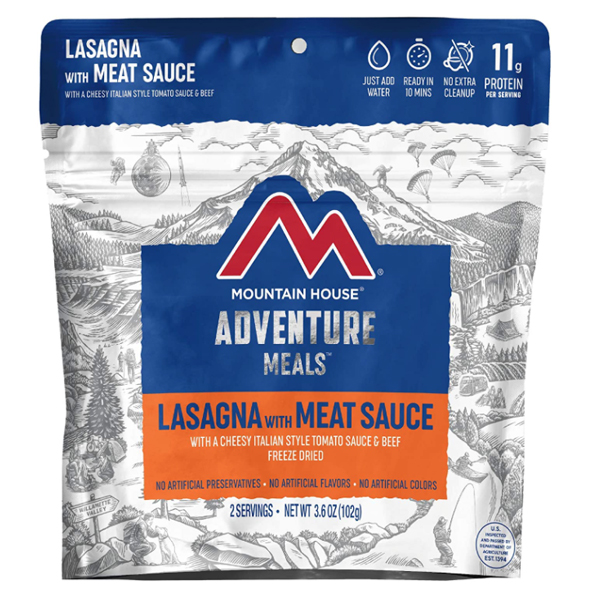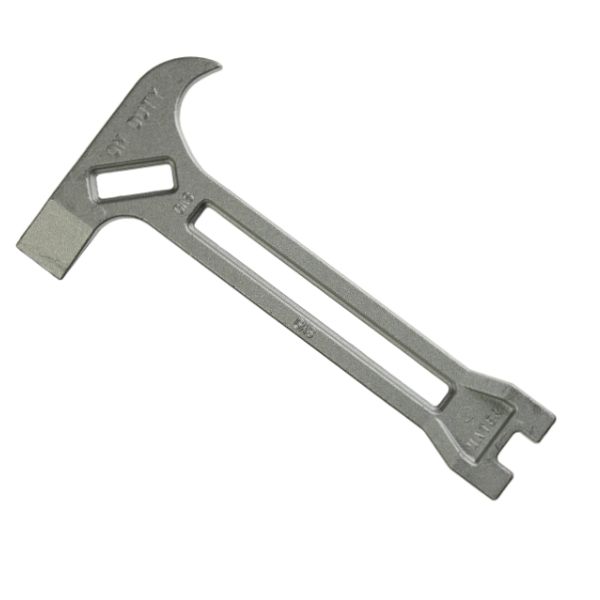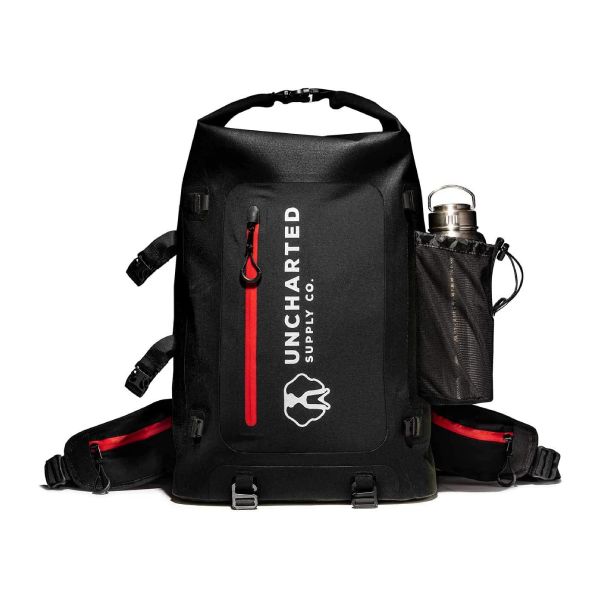Ultimate Survival System - Build Your Own Modular, DIY Emergency Kit
A Survival System is More than Just a Kit
Many people dabble in preparedness. They buy a kit, save a little cash, keep some extra toilet paper on hand and move on to the next worry. When the real emergency comes along they find that their supplies and options are very limited. True emergency preparedness requires more than just a kit. It requires a prepper's mindset and a system of gear and supplies. We call it a survival system.
Overview - Survival System Stages:
We recommend preparing to a larger scale. We recommend investing in a survival system so you are ready to protect and provide for yourself and your loved ones. We recommend applying stages to your system so you can be mobile, organized, and flexible. The gear and supplies should be high-quality and stand up to the rigors of long term use.
- Stage 0: Every Day Carry (Personal) - Items you carry every day to solve basic problems
- Stage 1: Essentials Pouches (Personal) - Modular gear pouches with the bare essential gear for a survival situation
- Stage 2: Go Bag (Bug Out Bag) (Personal) - Backpack with modular gear and compliments the essentials pouches. Adds gear for extended time away from home
- Stage 3: House Kit (Family/Household) - Bins of household gear and compliments the go bags, adds gear for the family for an extended stay away from home
- Stage 4: Bulk Supplies and Equipment (Family/Household) - Supplies and equipment for long term survival for a family or household in shelter in place situation
Over the years I've become more of a prepper. The news is full of stories of natural disasters and man made events that disrupt life and drive people from their homes. Every region of the country has climate threats. The nation as a whole is subject to economic factors. It's only a matter of time before each of us has our preparedness tested in one way or another. Our goal is to survive with the right gear, supplies, and skills.
Experience: 10 Days Without Power
A few years ago a large weather front passed through our area causing very strong winds. We live in a forested area and trees were blown down all over. Dozens of power lines were compromised. Within minutes the power was out in the whole area. By morning the power crews were hard at work but the power company reported to the news that residents should plan on several days before power could be restored to all areas.
Immediately people started wondering how they were going to keep their food from spoiling and power cell phones and other devices to continue to work and connect. People who couldn't get news updates had no idea how long the power might be out. It was a bit daunting.
We were very fortunate. The powerlines in our neighborhood are buried. Once the main lines in the city were restored our power came back on. We were only without power for a couple of hours. Others with generators kept food cold and other required services going.
Some of our friends and church associates were without power for up to 10 days. People with resources helped those without. We hosted people to do their laundry, take a hot shower, and charge their devices in our home. They commonly expressed how they hadn't ever thought about how much we rely on the grid for our comforts and survival - we take it for granted.
Needless to say, generator sales spiked during and after the event so people are ready for the next one.
You often don't realize how much you rely on something until it's gone. Being prepared means you have alternate solutions for the things you need.
There are a few required steps to be prepared:
- Emergency Plan - At minimum, we should have an emergency plan for our household. If we are members of churches, schools, businesses, etc we should consider emergency plans as well.
- Emergency Gear and Supplies - We should be ready with mobile-ready necessities for survival.
- Emergency Training - We should practice our plan and how to use our gear and supplies.
This article focuses on the survival gear and supplies. It includes instructions on how to build a custom, modular, DIY survival system along with a survival gear list and links to recommended products.
About This Article
Content:
Scope:
Difficulty:
Table of Contents
- Intro - Survival Systems
- Custom/DIY Approach
- Principles of a Great DIY Survival System
- Buy Quality Gear
- Modular Organization
- Buy on a Budget
- Train Your Household
- Prioritize in Stages
- Modular, DIY Survival System Stages
(includes recommended product lists) - Survival Priorities
- Stage 0 - EDC (personal)
- Stage 1 - Emergency Essentials (personal)
- Stage 2 - Go Bag (BOB) (personal)
- Stage 3 - House Kit (household)
- Stage 4 - Bulk Supplies and Equipment (household)
- Survival Favors the Prepared
Customize Your Survival Kit
Basic Emergency Kits Are A Great Start, But They're Limited
Basic emergency kits are ready-made collections of gear set aside for an emergency. Often they consist of a backpack full of some simple tools, basic first aid, a few water bottles and food. They provide the very basics for short periods of time. Ready-made survival kits are a perfect start for people with a tight budget or little time and expertise for assembling the right gear. However, ready-made kits may not have everything you need when a real emergency happens. Many people get a false hope that they are set since they have their kit. While they're a great start, a simple kit is very limited.
Build a Custom/DIY Survival Kit
To overcome the limits of ready-made, one size fits all kits we strongly recommend you build a custom survival system that fits your situation. It should be tailor-made to your household and circumstances.
Being prepared requires a system of gear and supplies to handle any number of emergencies. Build your own kits and assemble your own supplies. We'll show you how below.
Shop Our Survival Gear Catalog
Recommended Products
Excursion Gear Organizer (Tactical, Full Size, MOLLE)
Gear organizer for tactical and hiking backpacks (full size, MOLLE)
Buy On AmazonHiking Backpack - Medium
Quality backpack for bug out bags, 72-hour kits or other emergency organization
Buy on AmazonRubbermaid Lockable Bin Container
Sturdy, lockable, plastic industrial totes/bins for survival gear
Buy on AmazonPrinciples of a Great Survival System
Survival Gear Priorities
We require certain survival priorities to be healthy and safe. The needs are prioritized by urgency. The gear we buy for each stage will have these priorities in mind. See the survival prioritie to the right.
Our gear and supplies are focused on these priorities. We should purchase critical gear and supplies first and organize it so it's portable and accessible.
Principles
Through years of personal experience and a lot of research we have learned several principles to guide our gear purchases and organization.
- Only buy quality gear and supplies - With gear, you often get what you pay for. Buy quality, highly reviewed gear.
- Organize your gear so it is modular - Keep your gear organized so you can move it from one container or bag to another.
- Establish a monthly buget - The overall budget for quality, flexible gear can be considerable. Set aside money every month to apply to the next priority product. Over time you'll accumulate life saving gear and supplies.
- Everyone in the household needs training - Everyone should know what the plan is and how to use gear during an emergency.
- Prioritize your gear in "Stages" - Some emergencies restrict how much gear you can take with you. Make sure the essentials are always with you.
Buy Quality Gear
With gear, you often get what you pay for. Buy quality, highly reviewed gear. We're not saying always buy the expensive option - we are saying don't buy cheap, gimicky products - buy something you can rely on when it counts. There's nothing more demoralizing than pulling out a tool when you need it only to have the tool break or fail. Buy the right tool for the job.
Experience: It Won't Turn Over
When we were first married we were pretty strapped financially. We spent a lot of time outdoors because we couldn't afford anything else. One day at Walmart I saw a jump starter used for charging and starting dead car batteries. We had recently helped someone start their car when they left the door ajar and the light ran down the battery. I imagined having the same issue when we were up in the hills and thought it was better to be prepared than stranded in the mountains. I bought the gadget and took it home and charged it up.
Sure enough, a few weeks later we were in town and someone left the truck door ajar. I smirked, thinking I was so wise. I grabbed the jump starter and followed the instructions to connect it to the battery. I tried to start the truck but no luck. My smirk disappeared quickly.
Turns out, after doing some research, the model I had purchased was well known for being power deficient. It couldn't produce the necessary output to start larger vehicles. My temptation to by the cheap model instead of a highly rated one ended up costing much more in the long run.
It's better to buy the right gear even if it costs a bit more.
Organize Your Gear in Modules
As you buy gear, organize it by function when possible. That way, you can move similar items around without scattering things all over. Use pouches, bags and containers as needed to separated and contain it. For example, put all of your toiletries in one bag or case. That way if you're looking for your toothbrush you aren't digging through duct tape, multi-tools and mess kits.
Survival gear should be prioritized so it is as accessible and mobile as possible. Sometimes we're limited to how much weight or bulk we can carry. For example, backpack camping has strict weight restrictions compared to car camping. Mountain biking outings allow for less gear than a fishing expedition where we have a boat or vehicle.
We should be able to carry as much necessary gear as possible without the weight and bulk becoming impractical. We should also be able to merge gear from one emergency system into another.
Here are some examples:
- First Aid - put all of your first aid supplies in a first aid pouch
- Basic Essentials - the most urgent gear goes in its own pouch (knife, lighter, matches, water filter, paracord, duct tape, crank flashlight, etc)
- Toiletries - put all cleaning items in one pouch (travel toothbrush and tooth paste, floss, camp soap, chapstick, etc)
- Communications - put radios, chargers, batteries, etc in a pouch or pocket
- Kitchen - keep portable mess kits and fuel together. Also keep larger stoves, pans, and flatware together.
The idea is to make similar gear easy to move from one location to another.
Build Your System on a Budget
Buy quality gear and buy the most critical items first. However, you don't need to break the bank to do it. No need to create an emergency by preparing for an emergency. :) Set aside some money every month. Shop around for deals. Build it up over time.
Train Your Household to Use the Gear and Supplies
Get everyone on the same page. Emergency gear isn't play gear. It shouldn't be raided for house hold activities because it'll end up scattered, lost and broken.
Train everyone where the gear is, how to use it and how to maintain it. Everyone should be ready to help out in an emergency.
Prioritize in Stages
Every emergency doesn't require or allow the same gear. Sometimes you can shelter in place and wait it out. You might have access to everything. However, sometimes people are evacuated. Evacuation can mean only packing up a vehicle with whatever will fit and leaving town. It can also mean grabbing whatever you can at a moment's notice and carrying it on your back. A system broken into stages can accommodate all of these scenarios.
Stages should be based on how critical the gear is and how much it weighs and how much space it takes up.
Survival Priority List
Priortize your gear and supplies based on this list.
- Air
- First Aid/Mental Health
- Communication
- Tools
- Shelter
- Warmth
- Water
- Food
- Hygiene
- Self Protection
- Extra Clothing
- Container
Survival Priorities Explained
Modular, DIY Survival System Stages
A survival system is a flexible, mobile collection of survival gear and supplies. It can be used for many different types of emergencies - including evacuation situations.
We're fans of having the right emergency gear for any situation. Building a custom DIY survival kit with personalized gear makes emergency survival much more realistic. The goal should be to get started and continue to add custom gear and supplies to fit your situation over time.
Survival Kit Stages:
Stage 0: Every Day Carry (Personal) - Items you carry every day to solve basic problems
Stage 1: Essentials Pouches (Personal) - Modular gear pouches with the bare essential gear for a survival situation
Stage 2: Go Bag (Bug Out Bag) (Personal) - Compliments the essentials pouches, adds gear for extended time away from home
Stage 3: House Kit (Family/Household) - Compliments the go bags, adds gear for the family for an extended stay away from home
Stage 4: Bulk Supplies and Equipment (Family/Household) - Supplies and equipment for long term survival for a family or household
The idea behind modularized gear is to be able to nest it into other bags and packs. A modular survival system let's you take a Russian-doll approach to ensure you always have the essentials while adding additional gear as weight limitations are reduced by circumstance.
Stage 0: Every Day Carry (EDC)
There are certain items I just don't leave the house without (unless I'm headed to the airport). I carry my wallet, a compact multitool and my mobile device. Some people carry a watch, lighter, notebook, jewelry pens and other gear. These items are all wearable or fit in pants or jacket pockets.
These handy items cover a large percentage of the challenges of everyday life. It's key to carry what's needed without overdoing it. Only carry what you need.
- Mobile Devices
Everyone carries a mobile phone these days. We recommend using one with a long battery life, a strong signal and navigation apps that can work without a connection. - Wallet
Men and women have varying philosophies about their wallets. I'm a minimalist. I carry a few cards, a small amount of cash in case a card isn't accepted, and some ID. Some people file receipts, showcase photo albums, among other items. Since nearly everything is digital these days most of those things are on my mobile device now. I recommend carrying a minimalist's wallet. - Compact Multi-tool
Carry a leatherman, Swiss Army Knife or something similar. Often, I see guys carry the biggest multitool they can find because it has all the features. However, they never use them all. They end up carrying around a lot of extra weight. - Key Chain
Anyone with a vehicle carries keys. Adding a small, functional tool (i.e. light, tool, pepperspray) to the key ring can be very handy. - Watch
Many watches have great information for survival. Some have similar apps and tools to modern phones. - Lighter
Many people carry ligthers even if they don't smoke. They can be handy in an emergency to start fire, cook food, signal others. - Paracord Bracelet
Some guys wear a bracelet made from braided paracord. Often the buckles have blades, compasses, ferro bars, and other tools. - Tactical Pen
A tactical pen can write, break glass and other functions. We often see these in glove boxes. - Flashlight
Portable flashlights come in many forms and sizes. Some people carry them on their person every day for work, etc. - Notbook
Students and workers often have logs, journals, notepads, etc on a daily basis.
EDC Tips
Tip: I find that 90% of the time I need a blade and pliers (stronger fingers). I carry the Leatherman Freestyle. It has a great serrated blade and a pair of pliers. It's lightweight and very sturdy. I've carried the same multitool around for over a decade and the blade is still sharp.
Tip of the day: Use pliers to untie knots - my fingers are often not strong enough to untie a synched up knot - pliers do the trick!
Related Topics

Recommended Products
Field Master Swiss Army Knife
Best Swiss Army Knife for emergencies and EDC - light weight folding multi-tool that covers everything
Buy on AmazonStage 1: Survival Essentials (Personal)
There are three critical survival essentials pouches you should build or buy first. Since they are modular and portable they can be carried in coat pockets, purses, brief cases, day packs, go bags, etc. They are absolutely must-have and the gear should be considered critcal.
- Essential Gear - Contains the bare minimum gear to survive away from home in a pinch
- First Aid - Contains the bare minimum supplies and medications to keep you healthy
- Toiletries - Contains essential hygiene supplies
Each person in our household has their custom version of these three pouches. We also added a version of these three pouches to each vehicle including the ATV. Seems like a lot of duplicate gear but we always have supplies handy and we all know how to use them.
Recommendation: This is how I use my essentials pouches
I spend A TON of time outdoors. My annual goal is to have 120 outings per year (be on the trail 1 of 3 days) including hiking, biking, camping, fishing, ATVs, etc. In 2020 I surpassed 180 outings. I'll grab the dog, a child, my wife, and head out. In all of these outings I've relied on my survival gear more times than I'd like to admit.
I pack them in my day pack, transfer them to the ATV when needed, transfer them to the backpacking pack on overnighters, transfer them to a waist pack when fly fishing, and so on. It's mind boggling how often I've needed to use something from those pouches. I've had to start fires, take allergy meds, use the Carmex, use the toilet paper, use the paracord, and so on. I consider my essentials pouches as required gear for all outings.
I admit that I don't have duplicate gear in my bug-out-bag but since these pouches are always with me. I replenish and maintain them regularly I would have them ready to stow in my go bag. I even have reserved space to drop them in and go.
Essentials Pouches Contents
Pack highly effective gear for the critical functions of life. Gear should be organized in pouches or small containers. A sample of recommended survival items includes:
Survival Gear
- Flashlight
- Knife
- Lighter
- Paracord (50 ft)
- Blanket or Bivvy
- Water Filter
- Duct Tape
- Compass
- Molle Pouch
- More...
First Aid
- Wipes: Alcohol
- Wipes: Sting Relief
- Cream: Antibiotic
- Ointment
- Cream: Burns
- Cream: Sun Screen
- Insect Repellent
- Tabs: Antacid
- Tabs: Tylenol
- More...
Survival Toiletries
- Pocket Tissues
- Toothbrush/Toothpaste
- Travel Floss
- Camp Soap
- Sunscreen
- Chapstick
- Body Wipes
- Cotton Swabs
- Feminine Hygiene
- More...
Related Topics

Required Emergency Essentials | Checklist
Recommended Products
Excursion Gear Organizer (Tactical, Full Size, MOLLE)
Gear organizer for tactical and hiking backpacks (full size, MOLLE)
Buy On AmazonCrank Flashlight
Rechargeable hand crank and solar powered LED flashlight for survival
Buy on AmazonStage 2: Bug Out Bag (BOB) (Personal)
A bug-out-bag (BOB) is a Go-Bag and is considered the optimal survival kit. It is intended to be a portable 'grab-and-go' evacuation pack with everything you need for long term survival. While we all hope we never have to use an emergency kit, if we ever do, we want to be prepared and mobile. This go bag should be ready and handy so you can evacuate immediately.
Recommendation: This is how we use our go-bags
There is one complete bug out bag in the house. Everyone else in the household has a go bag with clothing, gear and supplies that fits their individual needs. Each has a version of the essentials pouches plus a change of clothes, etc. Everyone knows where their bag is and knows it's ready.
When building your bug out bag assume you can carry your EDC plus one backpack full of gear. That means weight is a big factor so the gear must be high-priority and light weight. Your body size is a factor in how much weight you can carry. My pack is heavier than that of my kids and contains expanded gear.
Bug Out Bag Contents
The bug out bag compliments the survival essentials pouches. In fact, you simply insert the pouches into the bug out bag to complete it. The bag contains more gear and supplies for an extended stay away from home.
Survival Gear
- 2-way Radio
- AM/FM Radio/Charger
- Headlamp
- Multi Tool
- Field Knife
- Lighter (2)
- Tinder
- Paracord
- Camping Tarp
- More...
First Aid
- Coban Roll
- Trauma Shears
- Tabs: Ibuprofen
- Tabs: Imodium
- Chest Seals
- Tweezers
- Irrigation
- Vaseline
- Rolled Gauze
- More...
Survival Toiletries
- Toilet Paper
- Toothpaste
- Camp Soap
- Sunscreen
- Cotton Swabs
- Body Wipes
- Trash Bags
- Ziploc Bags
- Hand Sanitizer
- More...
Extra Clothes
- Dry Bag
- Underwear
- Socks
- Hat
- Gloves
- Base Layer
- Pants
- Belt
- Jacket
- More...
Food
- Water
- Portable Stove
- Portable Stove Fuel
- Modern Mess Kit
- Food Ready To Eat
- Dehydrated Food
- Spork
- Water Purification Tabs
- Hot Tea or Cocoa
- More...
Documents
- Documents
- Identification
- Cash
- More...
Related Topics

Recommended Products
Hand Crank/Solar Rechargeable AM/FM/SW Radio, LED Flashlight, Power Bank - Rugged
Emergency hand crank/solar powered energy source, radio, LED flashlight
Buy on AmazonRechargeable LED Headlamp 450 Lumens
Durable, rechargeable 450 lumen LED head lamp for hands free survival
Buy on AmazonStage 3: House Kit (Household)
A House kit (AKA Home Kit) is a family-sized expansion of the personal survival kits. It consists of survival gear, expansive first aid (perhaps a trauma kit), toiletries, food, water, etc.
The house kit is still mobile. It is organized into bins, duffles, and packs as needed. We assume weight is less of an issue but we're still limited to how much we can carry. For example, in an evacuation we're likely traveling in a vehicle. We can carry more than what's on our backs but we're still limited.
Recommendation: Our Survival Bin
Our family survival kit is a large waterproof storage bin intended for the family. It contains a duffle bag, several pouches and some stand alone gear.
We often take this kit on car-camping trips along with our camp kitchen bin. It's surprising how often we use the gear in this kit. We've used the first aid supplies, hand saw, hand warmers, frisbees, water bottles, cookware, etc. In fact, we've probably used most of it at some point. Between the two kits we can set up camp, cook food for multiple people, and live for some time in comfort.
We keep this bin with our camping gear so we can grab that gear as well if needed.
Many people store house kits near their camping gear so they can grab more supplies if needed. Some vehicles (i.e. trucks) can carry a lot of gear. In an evacuation, you may have some time to really load up.
Home Kit Contents
Pack family-sized, high-priority gear for the critical functions of life. Gear should be organized in packs, duffles, pouches or small containers so it is modular.
Survival Gear
- Duffles and pouches
- Tent
- Lantern
- Hatchet
- Gas/Water wrench
- Folding trowel
- Rope and Cordage
- Duct tape
- Stuff bags
- Much more...
First Aid
- Splints
- Large pads
- Mosquito repellent
- Sunscreen
- Airway tools
- Ace bandages
- Pressure bandages
- Tourniquet
- Cold compress
- More...
Survival Toiletries
- Shampoo
- Soap
- Hand clothes
- Comb/Brush
- Toothpaste
- Razors
- Feminine hygiene
- Birth Control
- Medications
- More...
Related Topics

House Kit (Home Kit) | Checklist
Recommended Products
Portable 5-Gallon Water Container
Portable, durable 5 gallon water containers for potable water transport
Buy on AmazonStage 4: Bulk Supplies and Equipment (household)
Supplies and equipment at this stage are intended for long term shelter-in-place situations. They include on-hand water storage, long-term food storage, tools, power tools, and more.
The idea is to maintain some form of normal, healthy life for your household and possibly community. You can survive indefinitely as you plant food, process clean water, manage waste, power critical power tools, and more.
Types of Bulk Supply and Equipment Items
- Stored: 2 weeks clean water (1 gallon per person per day)
- Stored: 1 year of food
- Tools for farming
- Tools to generate power (generator)
- Extra fuel
- Space heater
- Fan
- Etc.
In an evacuation these items can be added to the survival kits from Stages 1, 2 and 3. Carry as much food and water as you can.
Bulk Supplies and Equipment
Pack highly effective gear for the critical functions of life. Gear should be organized in pouches or small containers. A sample of recommended survival items includes:
Survival Gear
- Extra gas
- Generator
- Shovel
- Axe
- Firewood
- Pick axe
- Extension cord
- Portable heater
- Portable fan
- More...
Food Storage
- 3 months day-to-day
- 3 months dehydrated
- 6 months
- Grain
- Rice
- Beans
- Potatos
- Sugar
- 55 gallons of water
- More...
Related Topics

Bulk Supplies and Equipment | Checklist
Recommended Products
Multi-Fuel Generator
Dual fuel porable generator with electric start for emergency power
Buy on Amazon55-Gallon Water Barrel
Durable water storage containers for 55 gallons of potable water
Buy on AmazonSurvival Favors the Prepared
Whew! There's a lot that goes into building a survival system. If you're just starting out, begin with the basics and work up. If you're already experienced, keep it going.
People who are prepared with survival gear, supplies, and equipment fair much better in an emergency. They tend to be better trained and exposed to answers difficult decisions.
Be prepared for you and your loved ones.
1This post may contain affiliate links. If you make a purchase, I may earn a small commission at no additional cost to you.
2 As an Amazon Associate we earn from qualifying purchases.
3 Most reviews are based on personal experience from one of our content editors. Some are based on research and the opinions of other reviewers.



